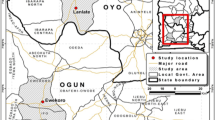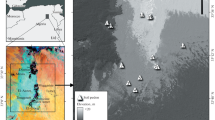Abstract
This study contemplates the geochemical and mineralogical characterization with spatial analysis of the following soil parameters of the “Alto de Santa Tereza” hillside in Recife/Brazil: granulometric; morphoscopic; compositional; chemical; and mineralogical. The general objective of the present study is report on how the weathering in the soil of the slope influenced on the occurrence of landslides. For this purpose, particle size analysis, X-ray diffraction, X-ray fluorescence, Scanning Electron Microscopy, and binocular lens observation were performed. On the studied slope, it was possible to identify two distinct sedimentary facies for the Barreiras Formation sediments: alluvial fans and fluvial channels/floodplains. Featuring, for the most part, sandy-clayey soil with prismatic and spherical, sub-angular to angular quartz grains, moderately selected. Kaolinite and quartz are the predominant minerals in the samples, and silicon oxides and aluminum are the components with the highest percentage. It was noticed that there is a relationship between Ki (silica/alumina ratio) and Kr (silica/alumina ratio and iron oxide) for the studied soils, the Ki values increase linearly with the increment in Kr. The weathering indices demonstrate that the studied soils of Barreiras Formation presented intense chemical alteration. The locations of the previous landslides in region of Recife show that most of the landslide occurrences are associated with the highly weathered zone.








Similar content being viewed by others
Data Availability
Not applicable.
Code availability
Not applicable.
References
Albers APF, Melchiades FG, Machado R, Baldo JB, Boschi AO (2002) Um método simples de caracterização de argilominerais por difração de raios X. Cerâmica 48(305):34–37. https://doi.org/10.1590/S0366-69132002000100008
Andriotti JLS (2003) Fundamentos de Estatística e Geoestatística. Editora Unisinos/Universidade do Vale do rio dos Sinos, São Leopoldo, p 165p
Bandeira APN, Coutinho RQ (2015) Critical rainfall parameters: proposed landslide warning system for the Metropolitan Region of Recife, PE, Brazil. Soils Rocks 38(1):27–48
Briggs DJ (1977) Sediments. Butterworth-Heinemann Ltd
Brito ATA (1981) Estudo químico e mineralógico de um perfil de alteração de ganisse migmatítico do campo experimental da PUC-RJ, Gávea, Rio de Janeiro. Dissertation. Federal University of Rio de Janeiro
Camapum de Carvalho J (2004) Propriedades e comportamento de solos tropicais não-saturados. 5° Simpósio Brasileiro de solos não-saturados 2:1–22
Camapum de Carvalho J, Barbosa MC, Mendonca RMG, Farias WM, Cardoso FBF (2015) Propriedades químicas, mineralógicas e estruturais de solos naturais e compactados. Solos não saturados no context geotécnico. ABMS 1:39–78
Camargo MG (2006) Sysgran: um sistema de código aberto para análises granulométricas de sedimentos. Revista Brasileira de Geociências 36(2):371–378
Cardoso FBF, Martins ES, Camapum de Carvalho J (1995) Micromorphological evolution of colapse in deeply weathered tropical soils, X Panam. Conf Soil Mech Found Eng 1:57–65
Cardoso FBF, Martins ES, Camapum de Carvalho J (1998) A Evolução Pedogeoquímica e Sua Influência Nas Propriedades Físicas dos Solos Profundamente Intemperizados do Distrito Federal. XI COBRAMSEG 1:51–58
Coutinho RQ, Silva MM, Santos AN, Lacerda WA (2019) Geotechnical characterization and failure mechanism of landslide in granite residual soil. J Geotech Geoenviron Eng (ASCE). https://doi.org/10.1061/(ASCE)GT.1943-5606.0002052
Coutinho RQ, Souza Neto JB, Santos LM, Lafayette KPV (2006) Geotechnical characterization of on unsaturated soil in the barreiras formation, Pernambuco, Brazil. Unsaturated Soils Conf Arizona 2:1627–1638. https://doi.org/10.1061/40802(189)136
Cronan DS (1972) Skewness and kurtosis in polymodal sediments from the Irish Sea. J Sediment Petrol 42:102–106. https://doi.org/10.1306/74D724A0-2B21-11D7-8648000102C1865D
De Ploey J, Poesen J (1985) Aggregate stability, runoff generation and interril erosion. Geomorphol soils. https://doi.org/10.4324/9780429320781-5
Dias JA (2004). A análise sedimentar e o conhecimento dos sistemas marinhos (Uma Introdução à Oceanografia Geológica). University of Algarve, UALg, E-book available at: http://w3.ualg.pt/~jdias/JAD/eb_Sediment.html. Acesso em 30/03/2020
Ferreira HN (1985) Characterization, identification and classification of tropical lateritic and saprolitic soils for geotechnical purposes. First Int Conf Geomech Trop Laterit Saprolit Soils 3:139–170
Folk RL, Ward WC (1957) Brazos river bar: a study in the significance of grain size parameters. J Sediment Petrol 27:3–26. https://doi.org/10.1306/74D70646-2B21-11D7-8648000102C1865D
Fonseca AP (2006) Análise de mecanismo de escorregamento associados a voçorocamento em área da Bacia do Bananal (SP/RJ). Thesis, Federal University of Rio de Janeiro
Greeland DL, Rimmer D, Payne D (1975) Determination of the structural stability class of English and weish soils using a water coherence test. J Soil Sci 26:294–303. https://doi.org/10.1111/j.1365-2389.1975.tb01953.x
Guerra DL, Sousa JA, Airoldi C, Viana RR (2008) Avaliação da eficiência de caulinita intercalada com dimetilsulfóxido em adsorção com o Zn(II) em meio aquoso cinética do processo de adsorção. Cerâmica 54:273–279. https://doi.org/10.1590/S0366-69132008000300002
Gusmão Filho JA, Justino da Silva JM, Jucá JFT, Ferreira SRM (1986). Parâmetros Geomecânicos dos Solos dos Morros de Olinda. VIII Congresso Brasileiro de Mecânica dos Solos e Engenharia de Fundações - COBRAMSEG, 1:199–210. Porto Alegre-RS
Instituto Brasileiro de Geografia e Estatística (IBGE) (2007). Manual Técnico de Pedologia. 2nd edn, Rio de Janeiro
Kottek M, Grieser J, Beck C, Rudolf B, Rubel F (2006) World map of the Köppen Geiger climate classification updated. Meteorol Z 15(3):259–263. https://doi.org/10.1127/0941-2948/2006/0130
Lafayette KPV (2006) Estudo Geológico—Geotécnico do Processo Erosivo em Encostas No Parque Metropolitano Armando De Holanda Cavalcanti—Cabo De Santo Agostinho/PE. Thesis. Federal University of Pernambuco
Lafayette KPV, Cantalice JRB, Coutinho RQ (2011) Resistência à erosão em ravinas em latossolo argilo arenoso. Revista Brasileira De Ciência Do Solo (Printed) 35:2167–2174. https://doi.org/10.1590/S0100-06832011000600031
Lennan SM (1993) Weathering and global denudation. J Geol 101:295–303. https://doi.org/10.1086/648222
Martins LR (2003) Recent sediments and grain size analysis. Revista Gravel 1:90–105
Mello VFB (1972) Thoughts on soil mechanics applicable to residual soils. Southeast Asian Conf Soil Eng Hong-Kong 3:5–34
Mendes RM, de Andrade MRM, Tomasella J, de Moraes MAE, Scofield GB (2018) Understanding shallow landslides in Campos do Jordão municipality—Brazil: disentangling the anthropic effects from natural causes in the disaster of 2000. Nat Hazard 18(1):15–30. https://doi.org/10.5194/nhess-18-15-2018
Migoń P (2013) Weathering and hillslope development. Treatise Geomorphol 4:159–178. https://doi.org/10.1016/B978-0-12-374739-6.00075-0
Milititsky J (1985) Solos tropicais e suas aplicações em fundações. Colóquio Solos Tropicais e suas aplicações na Engenharia. Porto Alegre
Monteiro DNC, Horbe AMC, da Silva CC (2007) A caulinita de perfis intempéricos sobre a Formação Alter do Chão - Estudo de difração de raios-X, microscopia eletrônica de varredura e espectroscopia de infravermelho e termogravimétrica. Contribuições à Geologia Da Amazônia 5:133–142
Moraes Filho JCR, Mello RC, Saadi A (1999). Projeto Porto Seguro/Santa Cruz Cabrália. CPRMSUREG/SA, Salvador
Nagatani TC (1987) Development of an ultra high resolution scanning eléctron microscope by means of a fild emission source and inlens system. Scanning Microsc 11:901–909
Piló LB, de Castro SS (2020). Soils of the Lagoa Santa Karst. In Lagoa Santa Karct: Brazil’s Iconic Karst Region. Springer. pp 93–108
Polivanov H (1998) Caracterização química, física, mineralógica e geotécnica de perfis de alteração desenvolvidos de gnaisses. Thesis, Federal University of Rio de Janeiro
Prado H (1995) Solos tropicais, potencialidades, limitações, manejo e capacidade de uso. Piracicaba—São Paulo, Brasil
Regmi AD, Yoshida K, Dhital MR, Devkota K (2013) Effect of rock weathering, clay mineralogy, and geological structures in the formation of large landslide, a case study from Dumre Besei landslide. Lesser Himalaya Nepal Landslides 10(1):1–13. https://doi.org/10.1007/s10346-011-0311-7
Rendón MI, Viviescas JC, Osorio JP et al (2020) Chemical, mineralogical and geotechnical index properties characterization of volcanic ash soils. Geotech Geol Eng 38:3231–3244. https://doi.org/10.1007/s10706-020-01219-3
Resende M, Santana DP (1988) Uso das relações Ki e Kr na estimativa da mineralogia para classificação dos latossolos. In: Meeting of Classification, Correlation of Soils and Interpretation of Agricultural Aptitude. Embrapa-SNLCS, Rio de Janeiro, pp 225- 232
Ribeiro AC, Guimaraes PTG, Alvarez VVH (1999). Recomendações para o uso de corretivos e fertilizantes em Minas Gerais: 5ª Aproximação. Soil Fertility Commission of the State of Minas Gerais, Viçosa
Rodrigues JG (2014). Caracterização Geoquímica e Mineralógica de Perfis de Intemperismo e sua Contribuição para Escorregamentos: o caso da bacia do Córrego do Príncipe, em Teresópolis—RJ. Dissertation, Federal Fluminense University
Rossetti DF (2004) Paleosurfaces from northeastern Amazonia as a key for reconstructing paleolandscapes and understanding weathering products. Sed Geol 169:51–174. https://doi.org/10.1016/j.sedgeo.2004.05.003
Sajinkumar KS, Anbazhagan S, Pradeepkumar AP, Rani VR (2011) Weathering and landslide occurrences in parts of Western Ghats, Kerala. J Geol Soc India 78(3):249. https://doi.org/10.1007/s12594-011-0089-1
Santos Júnior OF, Coutinho RQ, Severo RNF (2015) Propriedades Geotécnicas dos Sedimentos da Formação Barreiras no Litoral do Rio Grande do Norte. Geotecnia (Lisboa) 134:87–108
Sheldon ND, Retallack GJ, Tanaka S (2002) Geochemical climofunctions from North American soils and application to paleosols across the eocene-oligocene boundary in Oregon. J Geol 110:687–696. https://doi.org/10.1086/342865
Schellmann W (1979). Considerations on the definition and classification of laterites—Lateritisation process. Proc. International Seminar, India, Dec. 11/14—Balkema, Rotterdam, pp1–10
Shao J, Yang S, Li C (2012) Chemical indices (CIA and WIP) as proxies for integrated chemical weathering in China: inferences from analysis of fluvial sediments. Sed Geol 265:110–120. https://doi.org/10.1016/j.sedgeo.2012.03.020
Silva LF, Fruett T, Zinn YL, Inda AV, do Nascimento PC, (2019) Genesis, morphology and mineralogy of Planosols developed from different parent materials in southern Brazil. Geoderma 341:46–58. https://doi.org/10.1016/j.geoderma.2018.12.010
Silva MM (2007). Estudo geológico—geotécnico de uma encosta com problemas de instabilidade no município de Camaragibe. Thesis, Federal University of Pernambuco
Silva MM, Coutinho RQ, Lacerda W, Alheiros MM (2005). Caracterização geológica—geotécnica de um deslizamento numa encosta em Camaragibe, Pernambuco. In: IV COBRAE, Conferência Brasileira sobre Estabilidade de Encostas, 1:345–360, Salvador—Bahia
Skurzyński J, Jary Z, Kenis P, Kubik R, Moska P, Raczyk J, Seul C (2020) Geochemistry and mineralogy of the Late Pleistocene loess-palaeosol sequence in Złota (near Sandomierz, Poland): implications for weathering, sedimentary recycling and provenance. Geoderma 375:114459. https://doi.org/10.1016/j.geoderma.2020.114459
Sobral LF, Barreto MCV, Silva AJ, Anjos JL (2015) Guia Prático para Interpretação de Resultados de Análises de Solo. Embrapa Tabuleiros Costeiros, Aracaju
Sorokina OA (2020) Chemical composition of the Zeya River sediments in weathering trend of river sediments of Asia. Environ Earth Sci 79:49. https://doi.org/10.1007/s12665-019-8686-1
Souza Neto JB (2004). Comportamento de um solo colapsível avaliado a partir de ensaios de laboratório e campo, e previsão de recalques devidos à inundação (colapso). Thesis. Rio de Janeiro
Suguio K (2003). Geologia sedimentar. Ed Blucher, São Paulo
Vidalie JF (1977) Relations entre lês propriétés physico-chimiques et lês caractéristiques mécaniques des sols compressibles. Rapport De Recherche LPC 65:92
Walker LR, Shiels AB (2013) Physical causes and consequences for landslide ecology. Landslide Ecol 3:46–82
Xu C, Sun Q, Yang X (2018) A study of the factors influencing the occurrence of landslides in the Wushan area. Environ Earth Sci 77:406. https://doi.org/10.1007/s12665-018-7584-2
Funding
The authors are grateful to National Council for Scientific and Technological Development (CNPq) and the research group Geotechnical Engineering Group of Hillsides, Plains and Disasters (GEGEP/UFPE) for the financial support for conducting the research. They also thank all those who contributed to the tests: Laboratory of Marine Geology and Geophysics (LGGM), Northeast Strategic Technologies Center (CETENE), Stable Isotope laboratory of the Nucleus for Granite Studies (NEG-LABISE), Laboratory of the UFPE Geology Department, Laboratory of Environmental Chemistry of Soils—UFRPE and Electronic Microscopy Laboratory of the Physics Department/UFPE.
Author information
Authors and Affiliations
Contributions
All authors contributed to the study conception and design. Material preparation, data collection and analysis were performed by Tahyara Barbalho Fontoura, Roberto Quental Coutinho and Felipe Oliveira Tenório da Silva. The first draft of the manuscript was written by Tahyara Barbalho Fontoura and all authors commented on previous versions of the manuscript. All authors read and approved the final manuscript.
Corresponding author
Ethics declarations
Conflict of interest
The author’s declare that they have no conflict of interest.
Additional information
Publisher's Note
Springer Nature remains neutral with regard to jurisdictional claims in published maps and institutional affiliations.
Rights and permissions
Springer Nature or its licensor holds exclusive rights to this article under a publishing agreement with the author(s) or other rightsholder(s); author self-archiving of the accepted manuscript version of this article is solely governed by the terms of such publishing agreement and applicable law.
About this article
Cite this article
Fontoura, T.B., Coutinho, R.Q. & da Silva, F.O.T. Geochemical and Mineralogical Contributions in the Study of Sedimentary Rock (Barreiras Formation) Soils, Recife/Brazil: Implications for Landslides. Geotech Geol Eng 41, 205–224 (2023). https://doi.org/10.1007/s10706-022-02274-8
Received:
Accepted:
Published:
Issue Date:
DOI: https://doi.org/10.1007/s10706-022-02274-8




